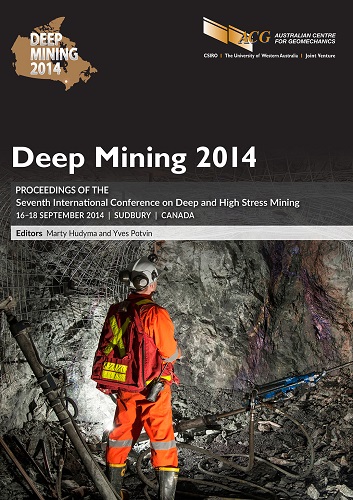A comparison of shallow and deep mining

|
Authors: Anderson, T |
DOI https://doi.org/10.36487/ACG_rep/1410_10_Anderson
Cite As:
Anderson, T 2014, 'A comparison of shallow and deep mining', in M Hudyma & Y Potvin (eds), Deep Mining 2014: Proceedings of the Seventh International Conference on Deep and High Stress Mining, Australian Centre for Geomechanics, Perth, pp. 181-187, https://doi.org/10.36487/ACG_rep/1410_10_Anderson
Abstract:
The challenges unique to deep mining are well known. There are countless examples of underground mines that have gradually progressed downwards and been forced to reassess their engineering design as they did so. It is, however, less common to see two mines simultaneously mining the same orebody at different depths, especially when both are operated by the same company and, to some extent, share technical staff and resources. If it were not for the difference in depth in a case such as this, it would be expected that the mines would have the same design practices. On the North Range of the Sudbury Basin, KGHM International operates a pair of neighbouring mines. McCreedy West Mine is extracting ore from the surface crown pillar down to a depth of approximately 450 m (1,500 ft). Levack Mine is excavating a down-dip extension of that same ore, currently developing over 1,500 m (5,000 ft) below surface. It would be expected for engineering design to be similar at each mine, but this is not the case. The seemingly incidental difference of depth dictates a substantial change in design. In most cases, but not all, this translates into larger engineering requirements for the deeper mine. But it is not merely the amount of care that goes into engineering design; the process that is used in this work also contrasts to a considerable degree. This paper is a detailed exploration of the differences in engineering design between KGHM International’s McCreedy West and Levack mines and the impact these design changes have on operations. The case study will consider ground control, ventilation, ore handling, mining method and the impact the differences identified have on the culture of the workforce.
© Copyright 2025, Australian Centre for Geomechanics (ACG), The University of Western Australia. All rights reserved.
View copyright/legal information
Please direct any queries or error reports to repository-acg@uwa.edu.au
View copyright/legal information
Please direct any queries or error reports to repository-acg@uwa.edu.au